|
< Earlier Kibitzing · PAGE 2 OF 2 ·
Later Kibitzing> |
Jun-30-18
 | | mifralu: Photo:
http://proxy.handle.net/10648/a8b34... |
|
Mar-23-19
 | | KEG: After a well-played opening in which Euwe obtained a small advantage, Keres unleashed a tactical display that blew Euwe away Euwe's error on move 28 allowed Keres to turn the tables by use of a fork Euwe had overlooked, and Euwe then went further astray allowing Keres to obtain a won game. Keres missed a faster win on move 39--and missed some other chances to wrap up the game with more celerity--but the outcome was not in doubt after move 30. This loss was the beginning of a disastrous tournament by Euwe, who ended with only one win and six draws in 20 games. This game set the pattern for what followed for Euwe in his effort to regain the crown. he got decent positions, but erred, often in time trouble as happened here. An understanding of the drama of this first-round game (when Euwe still had hopes of success) is enhanced by the contemporary commentary by the players and others. 1. e4 e5
2. Nf3 Nc6
3. Bb5 a6
4. Ba4 d6
The so-called Modern Steinitz Defense (aka Steinitz Defense Deferred). It was employed several times at the 1948 World Championship Tournament by Keres and by Reshevsky. "Keres has enjoyed much success both with and against this defence of recent years. Dr. Euwe was fully aware of this and had prepared himself theoretically to meet it, His handling of the opening stages is in fact admirable." (Golombek) 5. c3
5. c4, 5. 0-0 5. BxN+ (lauded by Keres in his commentary on this game) and even 5. d4 are all other reasonable variations for White. How long did Euwe ponder before playing 5. c3? Accounts differ: "A move played after long deliberation." (Euwe)
"Euwe made this move without long thought." (Keres). 5... Bd7
It was perhaps surprising that an attacking player such as Keres did not play 5...f5 here: "A good alternative is 5...f5." (Euwe).
"Very interesting here is 5...f5, which was the continuation preferred by Capablanca." (Keres). But the text has its points as well:
"Indicating his intention to preserved his centre intact and just sit tight till he sees what plan White is going to adopt. The other way of preventing BxN+, 5...b5, gratuitously weakens Black's Queen-side." (Golombek). 6. d4
He could equally wekk have played 6. 0-0.
6... Nge7
Another surprising (but definitely reasonable) choice from Keres. I would have guessed he would have played 6...Nf6. Much ink has been spilled on Keres' choice: "Although basically sound this line is too passive for most players." (Kmoch). "Steinitz' own move which aims at bringing the Knight to the defence of the e-pawn and so avoiding, for as long as possible, the exchange of this pawn for White's d-pawn. An alternative line is 6...h6 7. 0-0 Bg7 and if 8. Bg5 f6 9. Be3 Nh6, as played in the twenty-second match game between Alekhine and Bogoljubov, 1929." (Winter) "Seldom seen nowadays, but pure Steinitz in that at the expense of time and at the cost of a temporarily constricted position Black brings a piece to bear on the vital squares f5 and e4." (Golombek). "It is questionable whether the black king's knight is so much better positioned on g6 than on f6 that it's worth wasting a tempo on this mmove. But this entire variation by Black should be seen more as a search for less well-trodden pathes than as an attempt to find a flawless set-up." (Euwe). "With the text[manoeuvre Black plans to develop his knight to g6, from where it protects the e5-point and later threatens to occupy the strong square f4 in several lines. The drawback of the move is the loss of time that is entailed with the knight development, and especially the weakening of the central square d5, where White soon places his knight. Even though many theoreticians consider the text-move to be inferior...I still believe that 6...Nge7 is a playable system of defence. If Black, for instance, continues with 6...g6 7. 0-0 Bg7, he will find himself facing much more unpleasant problems than in the game after the simple exchange 8. dxe5.
In addition, 6...Nf6, which would lead the game into the so-called Kecskemet variation, would yiled Black a good game." (Keres) 
click for larger viewInterestingly, this same position was reached (via transposition of Black's 5th and 6th moves) in the 11th round game between Smyslov and Reshevsky--a game won by White. Indeed, the games did not vary until Black's 12th move. As will be discussed in my next and subsequent posts, Keres discerned latent tactical possibilities in Black's seemingly cramped formation, and the game soon became very sharp. |
|
Mar-23-19
 | | KEG: Post II
Keres and Euwe had played each other no fewer than nineteen times before the 1948 World Championship Tournament, with both players having seven victories (and Keres having come out one game ahead in their 14-game 1940 match). It was therefore doubtless a surprise that Keres demolished Euwe in the 1948 World Championship Tournament, winning four of five games and drawing the other. Returning to the instant contest after 6...Nge7 (in the diagrammed position with which I ended my last post): 7. Bb3
"...threatens Ng5 and so compels Black's next." (Winter) "After twenty minutes thought Dr. Euwe chose the line recommended by the Austrian theoretician, Becker. It is an attacking move that bears down on Black's weak point on f7, and so gives the opening strong resemblance to the Giuoco Piano. Normal development by 7. Be3 Ng6 8. Qd2 Nh4 gives Black equality.. [But White can keep an edge in this line with 8. d5 or 8. 0-0, and 8.,..Be7 or 8...Na5 are better than Golombek's 8...Nh4--KEG]. But 7. 0-0 Ng6 [7...h6 is better--KEG] 8. Re1 [better are 8. d5 or 8. Be3--KEG] keeps the initiative for White [but Black is OK in the above line after 8...b5]." (Golombek) "This is stronger than 7. h4...Now Ng5 is threatening to become unpleasant." (Euwe). "After Black has secured the e-point by Neg6, the light-squared bishop no longer has any prospects on a4, and for that reason its transfer to the a2-g8 diagonal is fully justifiable. Furthermore, it occurs here with the gain of a tempo, since Black has to play 7...h6 [7...f6 would not be awful, but 7...h6 is certainly best--KEG] in order to thwarts the threat of Ng5." (Keres) Euwe had two good alternatives here: 7. 0-0 or 7. d5. The text is also good for the reasons outlined by Keres. 7... h6
"Against the threatened Ng5." (Golombek).
The position was now:

click for larger view8. Nbd2
"An improvement [doubtful--KEG] on 8. Be3 which allows BLack easy equality by 8...Ng6 [White still seems better after 9. 0-0--KEG] 9. Nbd2 (citing the second 1942 Kashdan-Reshevsky match game." (Golombek) "The value of this move depends on whether White subsequently has to fear the g5 advance. In the game Ahues-Rubinstein, San Remo 1930, White continued with 8. Be3 and after 8...g5 sacrificed a piece by 9. Bxg5 hxB 10. Nxg5 d5 11. exd5 Na5 [11...Nxd5 seems to win for Black here, i.e., 12. Nxf7 KxN 13. Bxd5+ Kg7--KEG] As later analysis proved, instead of the text-move 12. dxe5 [which appears to lose after 12...NxB--KEG] 12. d6! [surely best, but not leading to an edge for White--KEG] NxB 13. QxN Nd5 14. Nxf7 KxN 15. dxc7 [15. Qxd5+ Be6 16. Qf3+ Ke8 is no better for White--KEG] Qxc7 16. Qxd5+ [but isn't Black still better after 16...Be6--KEG]. But this whole line is ot very convincing...White lost an important tempo by the manoeuvre Bc1-e3 xg5 that he could have used for his development...instead of 8...g5 Black should have proceeded with the quiet 8...Ng6, after this White's bishop would simply be unfavorably placed on e3, blocking the path to White's knight on its way to d5 via e3. [But White seems somewhat better in this variation--KEG]. Smyslov's idea to play 8. Nh4 would also not have been dangerous..." (Keres). Keres goes on to conclude that the text move (8. Nbd2) is "fully playable." Perhaps best for White after 7...h6 was either 8. d5 or 8. 0-0 (or perhaps 8. a4). 8... Ng6
Golombek and Euwe suggest 8...g5 as a good alternative, but after 9. d5 [better than Keres' suggested 9. dxe5 which does not yield much more than equality for White--KEG] Na5 [better than Golombek's 9...Nb8--KEG] 10. Bc2 White seems clearly better. 9. Nc4
"White's plan is to bring this Knight to a decent post at d5." (Winter). 9. 0-0 and 9. d5 are both good alternatives.
The position was now:

click for larger viewWhite (Euwe) is still better here, but as will be clear from what ensued Keres was probably not unhappy with his position, recognizing the possibilities for both sides in this complex variation. |
|
Mar-23-19
 | | KEG: Post III
9... Be7
Golombek here rightly condemned 8...Nf4 because of 10. BxN exB 11. d5 Ne7 12. e5 and White has much the better chances. But he was wrong in suggesting 12...Ng6 here for Black (Black is still in the game with 12...Nf5) and also wrong is suggesting 13. 0-0 in response to 12...Ng6 (13. e6 looks crushing). Keres rightly rejects 9...h4 here for Black since White then gets the better game with 10. NxN (which is even better than Keres' 10. Ne3). The text (9...Be7), however, was probably not best. 9...Qf6; 9...exd4; and 9...b5 all look better, but it was consistent with Keres' strategy of careful development and waiting for a chance to strike while keeping an eye on e5. The move (the only move even considered in MCO-13) was definitely not a significant mistake on any analysis. 10. 0-0
Better than MCO-13's 10. Ne3, but 10. d5 was most forcing and likely best. 10... 0-0
11. Ne3
The position was now:

click for larger view11... Bf6
Reasonable and adhering to Keres' strategy. 11...exd4 (clarifying the center); 11...Re8 (suggested by both Keres and Euwe); and 11....a5 seem to be the main alternatives. Several of the commentators, however, devoted their energy to considering 11...Nf4, which allows White to get the better game after 12. Re1. If instead 12. Nd5 (said to be the refutation by Winter and Golombek) Black is OK after 12...Ng6 (and not 12...Nxd5 13. exd5!) 12. Nd5
The game was now at a cross-roads:
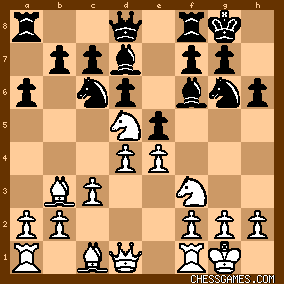
click for larger viewThis position was also reached in Smyslov-Reshevsky in the 11th round. Reshevsky played 12...Re8 and lost after 13. dxe5. While the commentators condemned Reshevsky's move, it does not look bad to me. When I get to the Smyslov-Reshevsky game, I will attempt to show that 12...Re8 was not the cause of Reshevsky's later woes. Euwe here played:
12... exd4.
The move discussed in most of the commentaries was 12...Bg4. This move is probably inferior to the text, but hardly the disaster suggested in the sources I have consulted; u.e., 12...Bg4 13. h3 BxN 14. QxB and now after 14...exd4 [14...Bg5 looks even better--KEG] 15. NxB+ (given as best by Golombek, and Kmoch; Keres' 15. Bxh6 yields only a small edge to White after 15...Bg5--KEG] QxN 16. QxQ gxQ 17. Bxh6 Rfe8 18. Rfe1 (18. Bc2 or 18. f3 are even better) leaves White somewhat better. 13. Nxd4
"!"--(Kmoch).
As Keres, Winter and Euwe have noted, 13. cxd4 would have left White awkwardly placed after 13...Bg4 "White has a substantial edge"--(Kmoch). [which game was he watching?) The best overall assessment at this point was that of Keres following Black's next move: 13... Re8
"After the exchange of central pawns, Black slightly relieves his cramped position, even though White still maintains a small spatial advantage. With the text-move, Black poses his opponent problems about how to protect the e4 pawn." (Keres). The position was now:
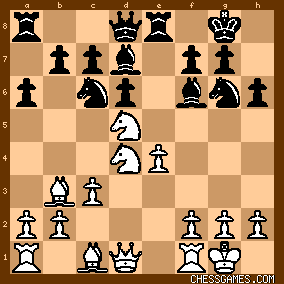
click for larger viewAs I will discuss in my next post on this game, in the above-diagrammed position Euwe faced a key decision. His choice probably cost him most of the advantage he had carefully nursed to this point. |
|
Mar-24-19
 | | KEG: Post IV
14. NxB+
It must have been tempting to cut down material against a dangerous attacking player such as Keres, but at what cost! The commentators were not kind in discussing this move by Euwe. "This gains the theoretical advantage of the pair of Bishops, but it greatly frees Black's rather congested position, and it is at least questionable whether White would not have done better to retain the Knight, at any rate, in the meantime." (Winter) "Gaining the technical advantage of two Bishis, nevertheless dissipating most of his opening advantage. White's superiorirty has consisted in the beautiful position of his two centralized Knights, and in the fact that his King's Bishop is an active attacking piece as opposed to the passive defense of Black's Queen Bishop. He must therefore evolve a plan to profit from these advantages." (Golombek). "Not bad but not strong either. White has an advantage in development and occupied territory and he should maintain it by protecting the e-pawn." (Kmoch). "Too early." (Euwe).
"Sucn ah exchange is not recommended unless there is an urgent need, since first of all Black is even more freed, and secondly the position is further simplified and offers fewer attacking possibilities." Okay, so if 14. NxB+ was not best, what should Euwe have played? Let's look at the possibilities: A) 14. f3. This defends the e-pawn and seems the logical choice. It certainly looks best to me, but not to most of the commentators. One commentator who mentioned the move--Kmoch--dismissed it by saying "...the position calls for [an eventual] f4]." My only ally in opting for 14. f3 (apart from is Fritz) is Golombek, who contended that it would allow White to "continue to centralise his pieces." B) 14. Bc2. This appears to have been the most popular choice: "Correct is 14. Bc2!" (Kmoch).
Euwe also preferred 14. Bc2, but only considered the reply 14...Be6 (which allows 15. NxB)e6) RxN 16. f4 with a big advantage for White. But Black can seemingly equalize with ease by means of 14...NxN 15. cxN (if 15. NxB+ QxN 16. QxN with approximate equality) c5! with sharp play and interesting prospects for both sides. Keres also chose 14. Bc2 as best, but only he recognized that after 14...NxN 15. cxN Bb5 (I think 15...c5! immediately is better, though Keres' move obviously had its points) 16. Re1 c5 Black obtains "adequate counterplay." C) Re1 is another seemingly good alternative that was nonetheless rejected by every commentator who mentioned it: "...not...14. Re1 because 14...Bg5 15. f4 Bh4 is annoying as 16. g3 weakens the King-side." (Kmoch). But after 16...Be7 in Kmoch's variation White has much the better game. Black's best chance to obtain equality after 14. Re1 (and the reason I do not advocate it) is because after 14...NxN 15. NxB+ (if 15. cxd4 Be6 and Black is fine) QxN 16. cxd4 Black's better pawn structure compensates for White's two Bishops and control of the center. "...the move 14. Re1 has its drawbacks; Black would then play 14...Na5 (I prefer 14...NxN but most concede I did not even think of 14...Na5) 15. Bc2 c6 16. NxB+ QxN and now White is unable to carry out the f4 advance." (Keres). [White does, however, seem to have the better game at the end of Keres' variation--KEG]. C) A wild possibility is 14. Nf5?! simply abandoning the e-pawn for the attack, e.g., 14...Rxe4 15. Nfe3 Re8 16. Qh5. I'm not sure this is sound, but I wouldn't want to face this line if I were Black. Returning Euwe's actual move: 14. NxB+, even if it was not best, it certainly did not lose the game. As Keres put is: "Although with the game continuation White makes some concessions, he still assures himself of a good position with the bishop pair and a slight initiative." This is surely the final (and best) word on 14. NxB+. 14... QxN
This left:
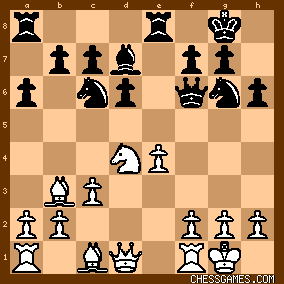
click for larger view15. f3
Was 15. Bc2 better? Kmoch says yes. But the choice is close and other commentators disagree: Golombek thought that after 15. Bc2 Black would get the better position after 15...Re7, but White then gets some edge after 16. f3 or 16. Be3. Keres' commentary includes an interesting discussion of the merits of 15. Bc2, ultimately rejecting the move because Black can simply play 15...NxN 16. cxN Bb5 [16...c5 immediately looks stronger--KEG] 17. Re1 c5. Keres also considered the wild attacking move 15...d5 after 15. Bc2. But after 16. NxN cxN (16...BxN 17. exd5 Bb5 looks better--KEG] 17. exd5 (17. f4 is stronger and appears to be the refutation of this variation--KEG] cxd5 18. Qxd5? Bc6 "with dangerous counterplay." But Keres overlooked the stronger 18. Qd4!which leads to an ending in which White has a small but persistent edge. I will pick up from here in my next post on this game. |
|
Mar-24-19
 | | KEG: Post V
After 15. f3, the position was:
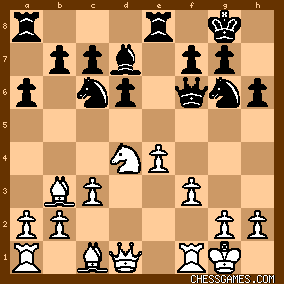
click for larger view15... Nf4
"threatens 16...NxN 17. cxN c5" (Wade-Whiteley-Keene) "Threatening 16...NxN 17. cxN Qxd4+ 18. QxQ Ne2+" (Winter). But Euwe and Keres were critical of 15...Nf4:
"This will turn out to be ultimately a waste of time. Correct is 15...Na5 16. Bc2 c5" (Euwe) But Euwe's line does not leave Black significantly better than the line actually played. The best critique appears in Keres' commentary: "By this sally [i.e., 15...Nf4] Black, it's true, threatens Nxd4 followed by Qxd4+, but after the thwarting of this threat he just loses time and ends up worse off. A good plan instead was 15...Rad8 [Fritz and Stockfish agree], with the intention of answering 16. Be3 [16. NxN looks somewhat better--KEG] Na5 17. Bc2 [17. Re1 is probably best--KEG] c5 [strong, but even better would be 17...d5--KEG] with good counterplay." 16. NxN
"Black was threatening 16...NxN" (Euwe)
"White's reply is almost forced, for 16. Be3 can be met by 16...Na5." (Winter). "If 16. Be3 Na5" (Kmoch)
While the text (16. NxN) was probably best,the criticism of 16. Be3 is over the top. Let's hear from Keres on this: "16. Bee would be answered by 16...Na5. However, after the simple 16. Kh1 [17. Qd2 looks even better--KEG] Black would have had great difficulty in justifying his Knight sally." (Keres). 16... BxN
This recapture is passed over without comment in most commentaries. But Keres--who gives the text a "?"--looked deeper: "Surprisingly, Black abstains from the favorable opportunity to play 16...bxB, which would after 17. Be3 c5 have deprived the white bishop of the strong d4-square, and in some lines enabled Black to apply pressure on the b-file. It seems that Black in this case could have achieved an equal game. But now White can develop his pieces unhundered and start a dangerous attack on the kingside, against which Black has difficult in finding a satisfactory defence." But isn't White much better in Keres' line by playing 18. Qd2. But with 17...Ng6 (instead of Keres' 17...c5_ Black does indeed have approximately equal chances, thus supporting the general thrust of Keres' otherwise excellent comment. The position after 16...BxN was:
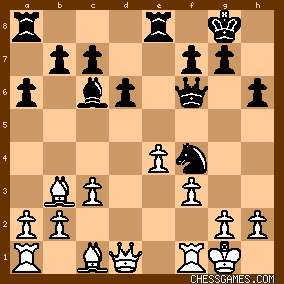
click for larger view17. Be3 Rad8
Retreating the Knight immediately by 17...Ng6 or 17...Ne6 were good alternatives, but the text also keeps White's edge to a minimum. 18. Qd2 Ng6
"The Knight is better advised to return to e6." (Euwe). But Keres disagreed:
"Now the consequences of Black's 15th move become apparent. The Knight is forced to retreat, leaving Black in a completely passive position. No better was 18...Ne6 19. Rae1." [Perhaps 19. Rad1 or 19. Rfe1 would be improvements on Keres' line, but his central point is what is important: Black's 15th move has left the initiative solidly in White's hands. The position was now:
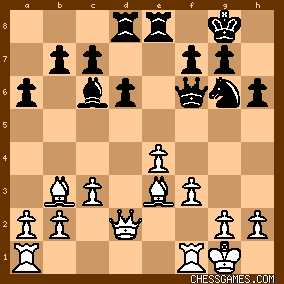
click for larger view19. Bd4
"A strong move after which Blaxk always has to reckon with possible sacrifices on g7." (Golombek) "White still has a good game but he lacks a good plan. An action on the Queen-side starting with 19. c4, merely to anticipate a counter-action there, was indicated. The text-move has no positive value." (Kmoch). I'm with Golombek in this debate. If 19. c4 Black has several good retorts all of which leave him in decent shape: e.g., 19...b6 or 19...Ne5. But either the text (19. Bd4) or 19. c4 leave White with wha initiative there is and a small advantage. 19... Qe7
19...Qg5 or 19...Qh4 were reasonable alternatives. The position now was:

click for larger viewWhat I have presented in my post thus far are only the appetizers for the struggle to follow. As I will discuss in my next post on this game, the game now became fascinating, and time pressure began to raise its ugly head. |
|
Mar-24-19
 | | KEG: Post VI
"Up to now White had taken some twenty minutes less on the clock than Black, the respective times reading: Dr. Euwe 1 hour 20 minutes, Keres 1 hour 42 minutes. But as the conduct of the game became increasingly difficult for White, he consumed more and more time from now on, becoming about level with his opponent by the 27th move." (Golombek) 20. Rae1
"White has still a very good position but is faced with the dilemma of whether to proceed with the attack on the Queen's side." (Winter) Bronstein and Winter thought the text was best and would have given Euwe good chances if properly followed up. 20. f4? would be bad in light of 20...Qxe4 and if then 21. f5 [21. Rae1 may be best, but White would still be in trouble] Qe2! Should Euwe should have played 20. c4, as claimed by Golombek, Wade-Whiteley-Keene, and Keres? Keres supplies the best argument for this: "White's position is superior and, by correct play, probably won. [An overstatement--KEG]. In order to achieve the win, the following kingside attack had to be well prepared, and in so doing Black's only counter-chance, which lies in the d5 thrust, had to be liquidated. By the text-move [20. Rae1] White prepares the f4 advance, but this plan still looks premature and yields Black unnecessary counterplay on the queenside. The correct continuation, in my opinion, was to play 20. c4! This move would have permanently deprived Black of all hopes of carrying out the liberating d5 thrust, and at the same time it would also thwart the possibility of ...Qd7 followed by ...Ba4, as occurred later in the game. In addition, the very strong 21. Qc3 would become a threat. It appears Black would thereafter been unable to defend himself against Rae1, Qc3, Bc2, and f4." While Keres' proposed 20. c4 rules out ...d5, White is nowhere near winning. If 20...b6, White would probably play 21. Rae1. Golombek and Kmoch fault the text move, saying White's Rooks should be placed on the c and d files. But in Keres' analysis, and in the lines I have explored, the a1 Rook often ends up on e1. My conclusion is that Euwe' move was OK and perhaps best, and had nothing to do with his loss of the game. The position after 20. Rae1 was:
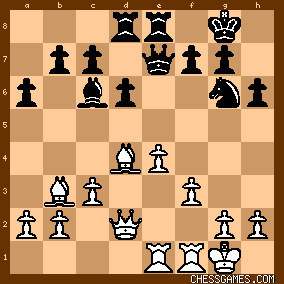
click for larger view20... Qd7
"Economical and menacing. The Queen is removed from the line of White's Rook, so allowing a possible d5; at the same time Ba4 is threatened." (Golombek) "Black now manages to exchange off one of White's strong bishops, since White can no longer prevent the positional threat of 21...Bb5 followed by ...Ba4 or d5. Even though several commentators still consider White's position to be clearly better [Fritz rates the position 0.32 for White before 20...Qd7 and 0.36 after; and Stockfish evaluates it as 0.28--in any case a small edge for White], I tend to believe that Black already has sufficient defensive resources, and that White spoilt his best chances on the previous move." (Keres) 21. c4
This move, though lauded by some on Euwe's turn, is faulted by nearly everyone. Let's look at the alternatives: A) Bc2
"What was good on move 20 [i.e., c4] is bad on move 21, this being due to White's mistaken Rook move. He should play 21. Bc2." (Golombek). But:
"Neither would 21. Bc2 give White an advantage: 21. Bc2 Bb5 22. Rf2 d5." [I am with Keres to this point, but 22...d5 allows 23. e5 giving White all sorts of chance. Either 22...c5 or 22...Ne5 are better and support Keres' evaluation. Keres goes on to say that after my suggested 23. e5 Black would play 23...c5 "with sufficient counterplay." But after 24. Bxc5 Rxe5 25. RxR NxR Bd4 White has all the chances]. B) 21. f4
"This time White could have gone forward: 21. f4 Bxe4 (21...Rxe4 is also possible) 22. Bxg7! It is doubtful, however, whether the liquidation KxB [overlooking the equalizing 22...Bxg2!--KEG] 23. Qd4+ Kh7 [23...f6 and 23...Kf8 would be better, though White would still have an edge--KEG] 24. RxB f5 [This courts disaster--24...c5 was essential--KEG] 25. RxR RxR...would offer White realistic winning chances. [But isn't White much better in Euwe's final position--KEG]. Nevertheless, White should have gone for this continuation, which entails no risk for him at all, since the text-move yields absolutley nothing." (Euwe) Keres, who also prefers 21. f4, followed Euwe' line through 23. Qd4+, but then played 23...Kg8 24. Rxe4. C) 21. a3
Keres exposed the error in this line: 21. a3 d5 (better than Euwe's proposed 21...Ba4) , but White's best, though not leading much of anywhere, would then be 22. exd5 rather than Keres' 22. e5 which gets White into "difficulties" after 22...Bb5 23. Rf2 b6. D) 21. Kh1
This suggestion by Konstantinopolskis was refuted by Keres' 21...d5! and White has no advantage. |
|
Mar-24-19
 | | KEG: Post VII
The position after 21. c4 was:
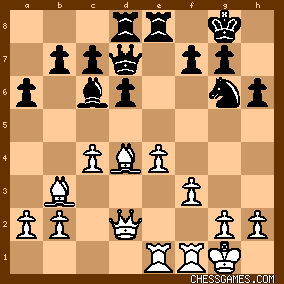
click for larger viewTo this point, despite the many criticisms and alternative moves suggested, play had been of a very high order. There had been no major mistakes, and neither side had been close to winning (or losing). 21... Ba4
"!"--(Golombek)
Keres, reasonably enpugh, decided to eliminate Euwe's white-square Bishop. "With every step that he takes into the middle game, Keres' play increases its vigour and subtlety. White is not allowed time for Bc3, Qc3, f4 and an eventual e5." (Golombek). 22. BxB
22. Qb4 would be no improvement, as Golombek noted: 22. Qb4 BxB 23. QxB b5 24. Rd1 [better than Golombek's 24. c5 which leaves an even game after 24...d5] 23. Rd1 leaving White with a minimal edge at most. The only good alternative to 22. BxB was 22. Qc3. This move only makes sense, however, if White is willing to respond to 22...BxB with 23. axB, accepting a pawn weakness in return for attacking chances. On balance, the text was probably best.
22... QxB
This left:

click for larger view23. Qc3 f6
"Black has almost completely equalized the game." (Golombek). The position was now:
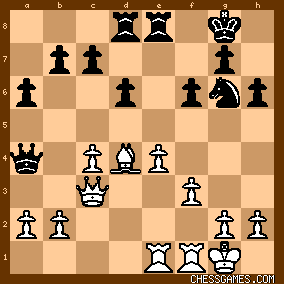
click for larger view"An important moment. Can White sacrifice on f6?" (Euwe). Winter said that White's best chance was 24. Bxf6?! Golombek said this was "not good." Let's see: 24. Bxf6?! gxB 25. Qxf6 Nf8 26. b3 [this move was recommended by both Winter and Golombek, but 26. Qh6 seems clearly better, leaving White with some compensation--three pawns for the sacrificed piece after 26...Qxc4 Qg5+ Ng6--KEG] and now simply 26...Qxa2 [instead of 26...Qd7 27. Qxh6 Qg7 as given by Winter and Golombek] with a likely win for Black. So the answer seems to be that the immediate sacrifice 24. Bxf6?! would be an error. So what should Euwe play? 24. f4
"?"--(Kmoch)(Euwe)(Wade-Whiteley-Keene).
"This weakening of the white center is motivated by nothing in particular [a king-side attack?--KEG] and is the start of White's problems." (Euwe) The consensus is that 24. b3 would have been better: "This is Euwe's first mistake. He is playing for a King-side attack threatening 25. Bxf6...but actually he only weakens his King pawn and thereby cuts down the mobility of his Queen. 24. b3 directly is better." (Kmoch) "Initially Euwe had planned to sacrifice the bishop by 24. Bxf6, but later considered this to be too risky and decided first to open up the third ran for his rook in order to support the attack. In fact, Black now manages to prevent the sacrifice and repulses White's attacking attempts. The f4 advance turns out to be just a weakening of the e4 point...it was better to abstain from a further weakening of the position and simply continue with 24. b3 followed by Rf2 with a roughly equal position." (Keres) Keres has pretty much said it all, though I still think Euwe was for choice after 24. b3. After Euwe's actual 24. f4, the position was:
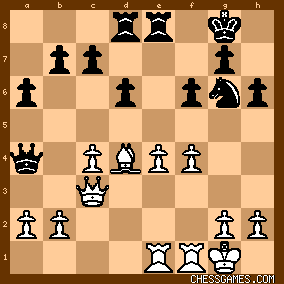
click for larger viewWith the weakening of his position, Euwe's advantage was now gone. As I will discuss in my next and coming posts, Euwe's efforts to continue to play for an attack from this point led to his demise in this game. |
|
Mar-24-19
 | | KEG: Post VIII
24... Kh7
"Eliminating the possibility of a successful sacrifice on f6 and in turn threatening to win either the e or f pawn by c5." (Golombek) "Preventing the sacrifice [on f6]." -- (Kmoch)
"Now Black's kingside is safe and he can commence operations against White's Queen's wing." (Winter) The assumption in all the above comments is that Keres needed to take steps to avoid 25. Bxf6. But--as Fritz and Stockfish confirm, Black can begin his own counter-attack immediately with 24...Qc6 and have much the better game. If then 25. Bxf6? Black simply plays 25...gxB 26. Qxf6 d5 putting an end to any hopes of an attack by White and obtaining the better--and possibly winning--endgame after 27. QxQ (what else?) cxQ 28. cxd5 cxd5 29. e5 Ne7 with Black having lost only two pawns for the sacrificed piece. After Keres' defensive 24...Kh7, White has at least equality. To make one obvious point, Keres could of course not have played 24...Qxa2 because of 25. Ra1 winning the Queen. 25. b3 Qd7
Of course not 25...Qxa2 26. Rf2 and the Queen is lost as was noted by Golombek, Kmoch, and Winter As on his previous move, Keres could and should have played 25...Qc6. After 25...Qd7, the position was:

click for larger view26. Qf3
"Black was threatening to win a pawn by 26...c5." (Winter) But there was a better way to address the c5 threat: 26. Qd3. This was especially the case given that Euwe played Qd3 on his very next move. "Black still threatened to win a pawn by c5, and the Queen move [i.e., 26. Qf3] is intended to support the e-oawn and prevent Black from playing Qg5. However, the latter threat is not at the moment important, and better is 26. Qd3." (Golombek). "Better is 26. Qd3 at once." (Kmoch).
"Better is 26 a4 or 26. Qd3." (Euwe).
After 26. a4, Black gets at least equality with 26...c5. Keres seems to have been on a different wavelength from the other commentators at this stage: "White still hopes to create some attack, but this attempt turns out to be incorrect, and even forces him to take up a defensive position. If White didn't want to defend passively against the threat of 26...c5 by for example 26. Kh1, he could have chosen the interesting double-edged attacking continuation 26. f5 Ne5 27. Qg3 [this could lead to trouble--better seems 27. Re2--KEG] Qf7 [27...b5 or 27...Re7 are better--KEG] 28. Rf4 [This can also lead to problems, 28. h3 is better here--KEG]. However, from an objective point of view, this would not have given him any genuine winning chances." Keres goes on to recommend 26. Qa5 as the way for White to play for "a roughly equal position,: but this could give Black chances with 26...c5! My conclusion is that 26. Qd3 was the only way for White to play for an advantage, and the text (26. Qf3 was good enough for equality. 26... b5
"!"--(Golombek)(Kmoch)(Euwe).
This move by Keres was praised by all the commentators: "By this admirably aggressive move, Black secures the initiative on the Queen-side." (Golombek) "Black has the better of the game [Doubtful--KEG] and herewith takes the initiative." (Kmoch) "A fine move which gives Black opportunities for stronb action on the Queens-wing." (Winter) "The signal for the counter-attack." (Euwe)
While 26...b5 precipitated a crisis in which Euwe ultimately faltered, and while it must have been a difficult move to meet over the board with the clock ticking, as a theoretical matter it should not have yielded anything for Black. 26...Re7 was also good. The position after 26..b5 was:

click for larger viewThe game at this stage was still in the balance. As I will discuss in my next post on this game, the climax of the contest approached. |
|
Mar-24-19
 | | KEG: Post IX
27. Qd3
This move was denounced by nearly all the commentators: "...this retreat is bad and gives Black the more promising game." (Keres) babacova on this site says that: "Euwe's problems begin when he plays 27. Qd3 which overlooks the work some moves down the line." The two main alternatives that have been advanced are 27. cxb5 and 27. Rc1. Keres and Golombek claimed 27. Rc1 was best. (Keres said it "had to be played"). But after 27...Re7 White will have to play cxb5 sooner or later and will be fighting for equality at best. Best is 27. cxb5 immediately, as was noted by Euwe himself. It avoids the recapture dilemma Euwe faced on his 28th move (when his problems truly began). Winter criticized 27. cxb5:
"If 27. cxb5 axb5 White's a-pawn is subject to attack while Black has the opportunity of obtaining a passed pawn by c5 and c4." But White has at least equal chances after 27. cxb5 qaxb5 28. g3 c5 29. Bf2 and if now 29...c4 30. bxc4 bxc4 31. Re3 Rc8 32. Rc1 and Black's c4 passed pawn ia at least as vulnerable as White's passed pawn on a3. Thus, I think 27. bxc5 was best. However, the criticisms notwithstanding, Euwe's 27. Qd3 was no serious blunder. The position after this move was: 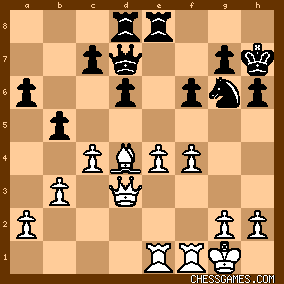
click for larger viewAs will be seen, Euwe would have been OK if not for his error on his next move. 27... bxc4
We arrive now at the key moment of the game, the position now being as follows with Euwe to recapture: 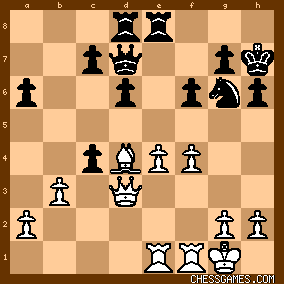
click for larger view28. Qxc4?
Euwe's first true blunder in this game. He overlooked Keres' brilliant response and the ensuing pawn fork. As everyone has noted, Euwe here had to play 28. bxc4. <babacova> is correct that this looks "antipositional and weak strategically," and <Honza Cervenka> is likewise correct that 28. bxc4 was the "lesser evil." But how bad would this have been for White, the position (hypothetically) being: 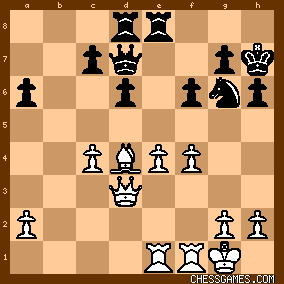
click for larger viewWhite's pawns do need tending here, as noted by Golombek and Keres, but the situation was not beyond repair. Fritz rates the game as 0.02 for White. Stockfish rates it as 0.06. This doesn't mean all that much, but is consistent with Keres' assessment that the game here would be "almost equal." One thing is certain, Euwe was correct in stating that after 28. bxc4 Black "would not yet be winning." After 28. Qxc4?, however, the position was:
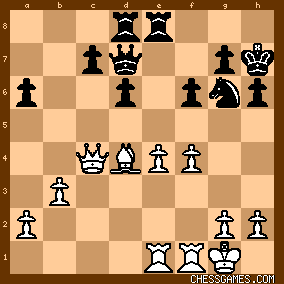
click for larger viewAs I will discuss in my next post on this game, it was in this position that Keres unleashed the tactical fireworks that won him the game. But as I will also discuss, and despite Keres' brilliant 28th move, Euwe was still far from lost and might have saved himself on his next move. |
|
Mar-24-19
 | | KEG: Post X
28... Rxe4!
According to Golombek, this fork combination came as a "complete surprise for White." The strength of the move should neither be overrated or underrated. As will be seen, Euwe was not lost even after this mini-sacrifice. As will further be seen, the power and brilliance of Keres' move went beyond the mere coming fork. The best assessment of where the game now stood was that provided by Keres: "As a result of this small combination Black gets a strong passed pawn on the e-file which, combined with the following attack on the king turns out to be very dangerous for White." The position after 28...Rxe4! was:
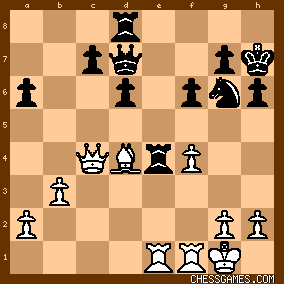
click for larger viewEuwe, who surely saw what was coming, played:
29. RxR?
The only comment on this move was by Kmoch-Horowitz: "The funniest incident of the evening occurred when Euwe was applauded as he played 29. RxR. Somebody who had just come in [this game was played the Hague] in thought that the Dutch master was winning a clear Rook!" Apart from the above, I have found no comment on 29. RxR. This is remarkable, since this was almost certainly the losing move. Had Euwe played either 29. Qd3 or 29. g3, the game would have been far from over. True, failure to play 29. RxR would have left him a pawn down. But now his weak e-pawn was gone and he would have had all sorts of counterplay. For example: 29. Qd3 d5 (the only way for Black to have an significant advantage) 30. Bc5 f5 31. g3 and White--though a pawn down--has a solid position and his Bishop is now better than Black's White. Black is for choice, but White is very much in the game. Alternatively, if 29. g3 Rde8 (or 29...d5 30. Qd3 Rde8 31. Rc1) 30. RxR RxR 31. Qd3. Once again, Keres would have good chances, but Euwe would have had real chances to survive. After 29. RxR, it quickly became clear that Euwe was lost, especially after Keres' vigorous 31st move. Euwe's careless 29. RxR is an indication of the difference between Euwe and players such as Lasker and Botvinnik. When the latter two players were surprised by a tactical shot by an opponent, they hunkered down and found ways to keep themselves in the game. At the 1948 World Championship Tournaments, Euwe's 4-16 score can be explained in large part by his inability to keep his head when he faced a crisis. The position after 29. RxR? was:

click for larger view29... d5
This left:

click for larger viewEuwe was probably lost here. After his next move (another blunder not mentioned in any of the commentaries), the game was over (or would have been had Keres not missed some faster winning methods in time trouble): 30. Qxa6?
The only comment I have found on this lemon was that of Kmoch: "White cannot okay 30. Qd3 because 30...dxR wins a piece, so he must leave Black the important center Pawn and take this unimportant one instead." But how about a counter-sacrifice by White here with 30. Qc2. Play could then get interesting: e.g., 30. Qc2 dxR 31. Ba7 Qf5 32. g3 Re3 33. Re1 Qd5 34. Qxc7. Black still is much better and probably has a win, but it's still a fight. 30... dxR
The position was now:

click for larger viewAs I will discuss in my next post on this game, material was now even, but Keres--as he quickly demonstrated--had the game in hand. |
|
Mar-24-19
 | | KEG: Post XI
31. Be3
"The Bishop must guard the second rank to prevent a major piece from penetrating there." (Golombek) 31... Qg4!
"!"--(Kmoch)(Euwe)(Keres)(Wade-Whitely-Keene)
A powerful shot:
"Suddenly Black holds all the trumps. The text move prevents the retreat of the White Queen to e2 and threatens 32...Nh4." (Euwe) "White would still be able to achieve a tenable position if he could bring his Queen back into play in time. But with the text-move Black initiates a direct mating attack and threatens 32...Rd3 as well as the manoeuvre Nh4-f5. White is defenceless against the combined attack of three pieces and the e-pawn." A diagram reveals the strength of 31...Qg4!:

click for larger view32. Qc4
Golombek claimed that 32. h3 would have been better, but Keres' comment on this point, and on the hopelessness of Euwe's position, seems definitive: "Attacking the pawn on e4 [referring to 32. Qc4] and in so doing, hoping to win time for the defence. But the attacking combination chosen by Black reveals the flaw in this plan. However there is no defence available against the above-mentioned threats, since for example after 32. h3 Qg3 33. Qe2 Black gains a winning position by 33...Nh4 34. Kh1 Nxg2 [!!--KEG]" Golombek continued his analysis past the end of the line given by Keres, but the result remains the same: "35. QxN QxB 36. f5 [36. Qg4 would be better than Golombek's move, but Black would still win after 36...Rd3] when, though Black should still win by 36...Kg8 37. Rg1 [37. Qg4 seems better, but that too loses after 37...Rd3] 37...Rd7 he would have to play most circumspectly." I must disagree. The position at the end of Golombek's variation was: 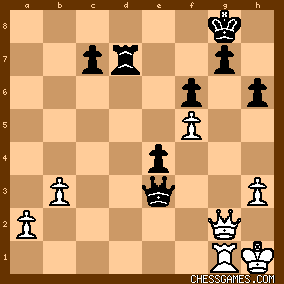
click for larger viewThis sure looks like a clear win to me.
By contrast, after Euwe's better (though not saving) 32. Qc4 the position was: 
click for larger viewIn fact, Keres--probably because of time pressure--began to miss the most forcing lines: 32... Rd3
"!"--Golombek)(Kmoch) (Euwe)(Wade-Whitely-Keene)(Keres) The commentators all loved this move:
"It is not necessary to defend the e-Pawn for if 33. Qxe4 Qe2 wins the Bishop." (Golombek) "With this powerful move Black keeps the attack going." (Kmoch). But, as will be seen, the move gave Euwe a chance [33. h3] he did not seize. But with the preliminary move 32...f5, Euwe would have been busted, e.g., 33. Qc2 Nh4 34. Kh1 Rd3. After 32...Rd3 the position was:
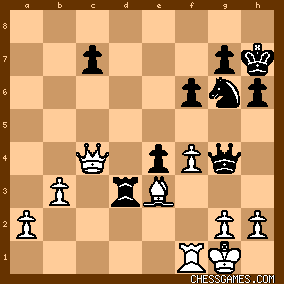
click for larger viewAs I will discuss in my next post on this game, in the above diagrammed position Euwe missed his last chance to offer any serious resistance, and the only reason the game was prolonged only because of some time-trouble errors by Keres. |
|
Mar-24-19
 | | KEG: Post XII
While many have commented on this game, the best analysis on the next portion of this game was by <Honza Cervenka> on this site back in 2011. In much of what follows, I have relied heavily on his excellent post on this game. 33. Bc1?
This move looks--and was--rotten. But while several suggested alternative moves were proposed, only <Honza Cervenka> found the best choice: 33. h3. Let's look at the moves that were discussed in the various commentaries, and then turn to Honza Cervenka: A) 33. Qxe4?
As previously discussed, and as nearly every commentator has noted, 33. Qxe4? loses to 33...Qe2. B) 33. Bf2
This move has been discussed by Golombek and Winter. It clearly loses to 33...Nxf4 34. Qxe4+ f5 35. Qc6 Nh3+ [the only way to have avoided this mate was by giving up the Queen with 35. QxN which was obviously hopeless]. C) 33.Re1
This--considered only by Golombek-- loses, not so much because of Golombek's 33...Nh4 34. Qxe4+ f5 35. Qb7 Rc3 (which is now a clear win for Black at all) but because of 33...f5 as noted by Keres [34. Qc2 Nxf4 35. BxN QxB]. D) 33. Qc1
Mentioned only by Kmoch. It loses to 33...Nh4 34. g3 Nf5 (even more crushing here iw 34...Nf3+) 35. Bd2 (if 35. Bf2 e3) e3 (35...Rxg3+ check is faster) 36. Be1 Nd4 (36...Rd1 is even better than Kmoch's move) 37. Qb1 (if 37. Qc4 Rd1) Qe2. Finally, we come to Honza Cervenka's move:
E) h3
"33.h3 Qg3 34.Bf2 Qxf4 35.Be1 with advantage to black but practical chances [of a] draw for white." (Honza Cervenka) This post says it all and I have nothing to add. I am surprised that no one else found this move which--while it may not ultimately save the game--was surely Euwe's best chance. BRAVO Honza Cervenka. The position after Euwe's 33. Bc1? was:

click for larger viewAs everyone seems to agree, Euwe was now a dead duck. 33... Nh4
"!"--(Golombek)(Kmmoch)(Wade-Whiteley-Keene)
"Another forcible stroke." (Golombek)
Golombek claimed that 33...f5 might allow White to save himself with 34. g4, but Black then wins with 34...Nh4. Keres himself recognized that 33. f5 is also a win, but still claimed his 33...Nh4 was best. In fact, the most crushing move here was 33...Qe2 (if 34. g3 h5 and White cannot last very long). But all of this is quibbling. Keres' move was more than sufficient, and should have won quickly. 34. Qxe4+
This was hopeless, but so was everything else.
If 34. Qc2 (best but of no avail) f5 (Keres)(Euwe). [Kmoch's 34...Rc3 is not as good, though that move would ultimately win as well]. If 34. g3 Black wins neatly with 34...Rxg3+ (Winter). 34... f5
35. Qb7
If 35. h3 Black wins with 35...Rxh3.
After 35. Qb7, the position was:

click for larger viewThe game sure looks over. But both players were now in terrible time trouble. As I will discuss in my next post on this game, Keres now missed several chances to close out the game quickly, and the game was extended to move 55, though the result was never in doubt. |
|
Mar-25-19
 | | KEG: Post XIII
35... c6
A clever way to win, but was there something even better? Some commentators simply praise 35...c6:
"!"--(Kmoch)
A very neat maneuver to force his Rook to the seventh rank." (Golombek) "One problem move after another." (Kmoch)
"Just another splendid move the effect of which is to enable him to reach the seventh rank with his Rook." (Winter) But others have looked deeper into the position and found the crushing 35...Rc3. Keres was in time trouble by now which may explain his choice of the text-move: "35...Rc6 was pretty, but 35...Rc3 was more precise." (Honza Cervenka) "Short of time, Black loses the thread. Simpler is 35...Rc3 (threatening c6)..." (Euwe") "In time trouble, Black chooses a forcing line, which finally gives him and endgame with an extra piece for two pawns. The same outcome, but with one more pawn for Black, would have been given by the simple 35...Rc3, which threatens c6 as well as Rc2..." (Keres) 36. Qxc6 Rc3
37. Qd5
The position was now:
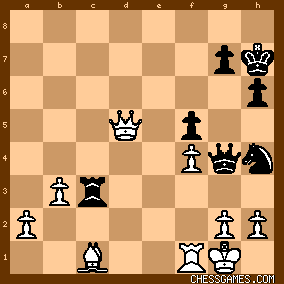
click for larger view37... Rc5?
"!"--(Golombek)(Keres)(Wade-Whiteley-Keene)
This much-praised move was in fact a serious inaccuracy. Only Honza Cervenka appears to have noticed this. As he--and he alone so far as I can discern--has pointed out that 37...Rc2 is best. Golombek, Kmoch, and Winter all considered 37...Rc2 but said that it fails after 38. Bd2. But Honza Cervenka has seen further and noticed that after 37...Rc2 38. Bd2 Black wins neatly with 38...Rc5! and (after 39. Qb7 or 39. Qa8) 39...Qe2 (and now if 40. Bc1 RxN 41. RxR Qe3+ and if 40. Be1 Rc1). BRAVO <Honza Cervenka) As Honza Cervenka also notes, after the text Euwe could have made matters tough for Keres had he not blundered on his 39th move and played 39.Qf2 instead of 39.h3?. The position was now (after 37...Rc5):
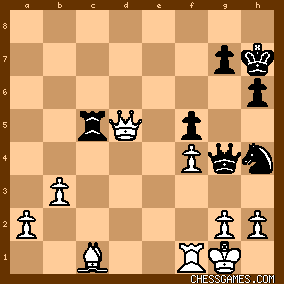
click for larger view38. Qd2
The best chance. Other moves would have resulted in a quick finish. As Golombek notes, 38. Qb7 fails to 38...Rc2 and then if 39. g3 [39. Rf2 holds out longer but is obviously hopeless after 39...RxB+) Qh3 40. Qh1 Rg2+ and mates next move. Keres claimed that 38. h3 was better, but (following his proposed line) 38...Qg3 39. Qd2 RxB 40. Qe2 either 40...Qxf4--or better still 40...Rc3--would be crushing. 38... RxB
"!"--(Kmoch)(Wade-Whiteley-Keene)(Euwe)(Keres)
"The Bishop and the game are lost." (Golombek)
"Now, if White recaptures he loses the King or Queen [i.e., if 39. QxR Qxg2 mate; and if 39. RxR Nf3+]. This is the point of Keres; combinational sequence." (Kmoch) "Winning a piece and the game. White could have resigned." (Winter) "The point of the combination." (Keres)
The position after 39...RxB was:
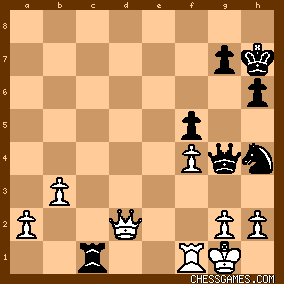
click for larger viewAs I will discuss in my next post on this game, Euwe here missed and chance to make Keres' task more difficult and instead blundered, allowing Keres to win immediately...a chance Keres missed allowing the game to be extended. |
|
Mar-26-19
 | | KEG: Post XIV
My reference to "39...RxB" should of course have read "38...RxB." The actual 39th moves were made in severe time pressure, and both players erred badly: 39. h3?
"?"--(Kmoch)(Euwe).
As will be seen, Keres could have won immediately after the text. "39. Qf2 had to be played." (Keres). Did Keres still have a easy win after 39. Qf2. Euwe and Honza Cervenka say no: "After 39. Qf2 Black would have had a hard time of it." (Euwe) Keres disagreed, and stated that:
"Black would also then have retained an easily won position after 39...Rc3." So who is right?
After Keres' 39...Rc3, play would likely have gone 40. Kh1 g5 41. g3 Qf3+ 42. Kg1 QxQ+ 43. RxQ Nf3+ 44. Kf1 gxf4 45. gxf4 Rc1+ 46. Ke2 (If 46. Kg2 Ne1+ and if 47. Kg1 Nd3+) Nxh2 47. Kd2 Ra1 48. a4 h5 This would leave:

click for larger viewThis sure looks like a win for Black, but this was all hard work and the position even here is not resignable. Thus, the position was indeed a win for Black, but Euwe and Honza Cervenka were also correct that Black had work to do after 39. Qf2. After Euwe's 39. h3?, the position was:
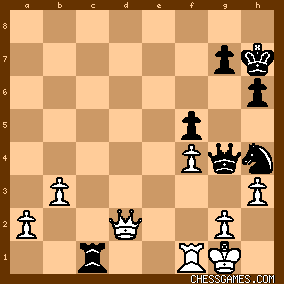
click for larger viewKeres here played:
39... Qg3
As every commentator has pointed out, Keres had a quick win with 39...Nf3+ (if 40. Kf2 [if 40. Kh1 RxRmate] RxR+ 41. Ke3 [if 41. KxR NxQ+] Qg3 42. gxN Qxf3+). Given all this, the characterization of 39...Nf3+ by <offramp> as a "cracker of a move" says it all. In fairness to Keres, however, two points must be made: (i) it is a lot easier to find a move like 39...Nf3+ when sitting with all the time in the world to examine the board; and (ii) Keres still had a win after his actual move 39...Qg3. Keres saw that 39...Qg3 led to a win and--faced with a possible loss on time if he took time to ponder--he made a move he could see would win. This lust leaves more play for us to examine.
The position after Keres; 39...Qg3 was:

click for larger view40. Qe2
As Keres and Kmoch pointed out, Black wins even more easily after 40. Qf2 by 40...QxQ+ [41. KxQ Rc2+]. 40... Qxf4
"What follows is of little interest." (Golombek) 41. RxR QxR+
This left:

click for larger view42. Kh2
42. Qf1 may have been slightly better, but Black still wins: 42. Qf1 Qc2 43. a4 g5] though his task may have been a bot harder. The game was here adjourned in the following position: 
click for larger viewThe game is pretty clearly a win for Black. I will discuss the play after adjournment in my next post on this game. |
|
Mar-26-19
 | | KEG: Post XV
42... Qf4+
"The sealed move. White cannot last much longer, as all tat is requisite for Black is to regroup his Queen and Knight to form a mating net." (Golombek) "Achieving the win no longer involves any difficulties, and Black only has to continue carefully so that White's queenside pawns will not become too dangerous." (Keres) 43. Kg1
43. Kh1 is no better.
If 43. g3, Black has various ways to win:
A) 43...Nf3+ (Golombek's move) which wins after 44. Kg2 Nd4 45. Qd3 [Golombek's 45. gxQ loses straightaway after 45...NxQ] Qe5 after which Black can foil any effort by White to advance his Queen-side pawns; B) 43...Qd2 (recommended by Euwe) gets the Queens off the board after 44. QxQ Nf3+ 45. Kg2 NxQ after which Black can win by using his Knight to hold back White's a and b pawns until his King ends the struggle, e.g., 46. b4 Ne4 47. a4 Kg6 48. a5 Nd6 and wins C) 43...Qd6 (Keres' move which wins after 44. a4 (44. Qe3 Ng6) Ng6 45. Qc3 f4! 46. gxf4 Nxf4 47. a5 Ng6+ 48. Kh1 Qe5 49. b4 Qe1+ winning the b-pawn and the game. The position after 43. Kg1 was:
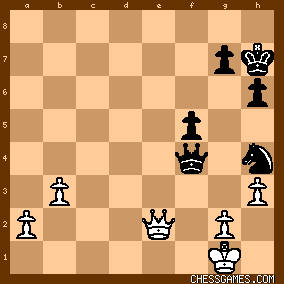
click for larger view43... Ng6
"The ending is winning for Black. Once he has transferred the Knight to a move central position, the rest will play itself." (Euwe) 44. Qc2
44. a4 Qd4+ 45. Kh1 f4 is no better for White.
44... Ne7
Getting the Knight into position to be able to keep White's Queen-side pawns in check and to be ready to snare White's King in a mating net. 44... Qd4+ was another way to win. 45. a4
Now or never.
45... Qd4+
46. Kh2 Qe5+
47. Kg1 Nd5
"Threatening 48...Qe1+ 49. Kh2 Ne3 50. Qb2 f4 51. b4 Nc1+ 52. Kg1 Ng3+ 53. Kh2 Qa1 mate." (Golombek) "Black is gradually preparing a mating attack with his Queen and Knight." (Winter). "Now White's pawns have been stopped and Black can start to carry out the second part of his plan: to create a mating net around the King." (Keres) The position after 47...Nd5 was:
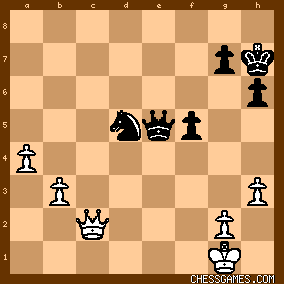
click for larger view48. Qd1 Nc3
48...Nf4 and 48...Qe3+ would also have done the trick. 49. Qc2
49. Qf3 might have allowed Euwe to hold out a bit longer. 49... Kg6
"Freeing the Queen from the defence of the f5 pawn." (Keres) "The King temporarily supports the f-pawn in order to free the Queen for the mating maneuver." (Golombek) The position was now:
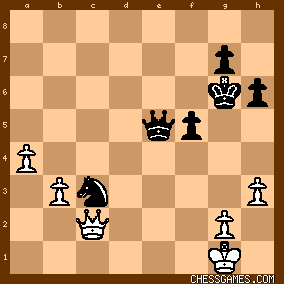
click for larger viewThe end was now in sight. I will discuss the finale in my next post on this game. |
|
Mar-26-19
 | | KEG: Post XVI
50. Kh1
Tantamount to resignation.
As Golombek has demonstrated, 50. Qd2 was hopeless in light of 50...Ne2+ 51. Kf1 (51. Kh1 was no better) Ng3+ 52. Kg1 f4 (52...h5 is even better, but White is busted in either case). The best way to hang on for a bit was 50. Qd2, though White would still be lost after 50...h5 50... Qe1+
51. Kh2 Ne2
"Thw execution begins." (Euwe)
51...h5 was even more crushing, but White is toast in any event. The position after 51...Ne2 was:

click for larger view52. Qc6+
This virtually invites the Black to join the mating attack. 52. Qc5 was the only way to prolong the game. 52... Kh7
Keres seems to be playing by rote here (or maybe time pressure was rearing its head again). 52...Kh5 or 52...Kg5 were faster. 53. Qc5
53. Qb6 no better.
53... Ng3
53...Qg3+ was faster.
54. Qd6
"Black wins by zugzwang after 54. Qg1 Nf1+ 55. Kh1 f4 (55...Qe2 is faster) 56. Qc5 (this allows mate in two. 56. a5 is the only way to extend the game for even a few more moves) 56...Ne3+ and mates in two (56...Ng3+ mates one move faster)." (Golombek) "If 54. b4 Nf1+ 55. Kg1 Ne3+ 56. Kh2 f4 [mating quickly--KEG]" (Golombek) The position was now (after 54. Qd6):

click for larger view54... Nf1+
55. Kg1 h5
As <babacova> has pointed out on this site, 55...Ne3+ was most precise . Euwe here attempted to play:
56. Qf4, but overstepped the time limit in doing so. The position (reckoning 56. Qf4 as being played, was: 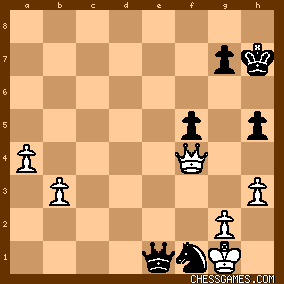
click for larger viewHad Euwe made his move in time, Keres would have won [as pointed out by nearly all the commentators] by 56...Ne3+ 57. Kh2 h4 with Nf1 to follow. 0-1 |
|
Sep-04-19
 | | KEG: I apologize for the typos in several of my posts on this game. I hope they do not unduly detract from the excitement of playing over and analyzing this fascinating contest. I can at least correct one of the typos. One of my comments on move 50 was: "As Golombek has demonstrated, 50. Qd2 was hopeless in light of 50...Ne2+ 51. Kf1 (51. Kh1 was no better) Ng3+ 52. Kg1 f4 (52...h5 is even better, but White is busted in either case)." Two corrections here. First, I was quoting Winter, not Golombek. Second, the reference in this quotation was to 50. Qf2, not 50. Qd2. Sorry about that! |
|
Jan-14-20
 | | plang: 8..g6 had been played in Wagner-Bunkmann Germany 1923 (White won); 8..Ng6 was new and is now the most popular option. Just starting to look at Keres book on the tournament - reinforces why he is one of my very favorite chess writers (and the game reminds me of why he is one of my favorite players). |
|
Jan-15-20
 | | KEG: <plang>This game and the annotations of Keres confirm--if indeed such were truly needed--Keres' greatness as a player (along with Korchnoi he was in my view one of the two finest players never to win the title throughout a long and distinguished career) and his excellent skills as an analyst. |
|
Oct-10-21
 | | GrahamClayton: Euwe's passed Q-side pawns are no match for Keres' superbly coordinated queen and knight. |
|
Oct-10-21
 | | perfidious: <KEG.....Keres and Euwe had played each other no fewer than nineteen times before the 1948 World Championship Tournament, with both players having seven victories (and Keres having come out one game ahead in their 14-game 1940 match). It was therefore doubtless a surprise that Keres demolished Euwe in the 1948 World Championship Tournament, winning four of five games and drawing the other....> It should be borne in mind that in 1948, Keres was approaching his zenith and, conversely, Euwe at 47 was already facing that most inexorable of opponents, Father Time. |
|
| Mar-18-22 | | cehertan: Disastrous indeed. It�s hard to imagine any GM, much less an ex-WC, losing the position around move 23. |
|
Dec-08-22
 | | Hasurami: Thank you KEG for all the effort you have put into these comments! |
|
Dec-11-22
 | | KEG: <Hasurami>So glad you have found what I have posted to be of interest. |
|
 |
|
< Earlier Kibitzing · PAGE 2 OF 2 ·
Later Kibitzing> |
|
|
|





